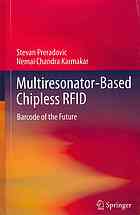

Most ebook files are in PDF format, so you can easily read them using various software such as Foxit Reader or directly on the Google Chrome browser.
Some ebook files are released by publishers in other formats such as .awz, .mobi, .epub, .fb2, etc. You may need to install specific software to read these formats on mobile/PC, such as Calibre.
Please read the tutorial at this link: https://ebookbell.com/faq
We offer FREE conversion to the popular formats you request; however, this may take some time. Therefore, right after payment, please email us, and we will try to provide the service as quickly as possible.
For some exceptional file formats or broken links (if any), please refrain from opening any disputes. Instead, email us first, and we will try to assist within a maximum of 6 hours.
EbookBell Team

4.3
8 reviewsThis vital new resource offers engineers and researchers a window on important new technology that will supersede the barcode and is destined to change the face of logistics and product data handling. In the last two decades, radio-frequency identification has grown fast, with accelerated take-up of RFID into the mainstream through its adoption by key users such as Wal-Mart, K-Mart and the US Department of Defense. RFID has many potential applications due to its flexibility, capability to operate out of line of sight, and its high data-carrying capacity. Yet despite optimistic projections of a market worth $25 billion by 2018, potential users are concerned about costs and investment returns. Clearly demonstrating the need for a fully printable chipless RFID tag as well as a powerful and efficient reader to assimilate the tag’s data, this book moves on to describe both. Introducing the general concepts in the field including technical data, it then describes how a chipless RFID tag can be made using a planar disc-loaded monopole antenna and an asymmetrical coupled spiral multi-resonator. The tag encodes data via the “spectral signature” technique and is now in its third-generation version with an ultra-wide band (UWB) reader operating at between 5 and 10.7GHz.